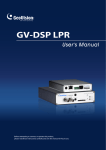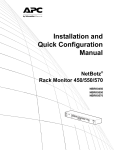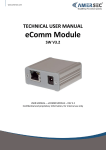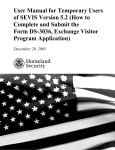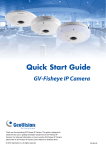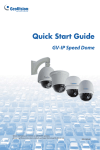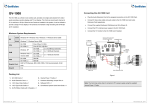Download Chapter 3 Accessing the GV
Transcript
GV-DSP LPR User's Manual V1.0 Before attempting to connect or operate this product, please read these instructions carefully and save this manual for future use. © 2008 GeoVision, Inc. All rights reserved. Under the copyright laws, this manual may not be copied, in whole or in part, without the written consent of GeoVision. Every effort has been made to ensure that the information in this manual is accurate. GeoVision is not responsible for printing or clerical errors. GeoVision, Inc. 9F, No. 246, Sec. 1, Neihu Rd., Neihu District, Taipei, Taiwan Tel: +886-2-8797-8377 Fax: +886-2-8797-8335 http://www.geovision.com.tw Trademarks used in this manual: GeoVision, the GeoVision logo and GV series products are trademarks of GeoVision, Inc. Windows and Windows XP are registered trademarks of Microsoft Corporation. March 2008 Contents Chapter 1 Introduction ..........................................................1 1.1 Key Features ............................................................................................................1 1.2 Packing List ..............................................................................................................2 1.3 System Requirements ..............................................................................................2 1.4 Physical Description .................................................................................................3 1.4.1 Front View ...................................................................................................3 1.4.2 Rear View....................................................................................................4 Chapter 2 Getting Started .....................................................5 2.1 Installing on a Network .............................................................................................5 2.2 Assigning an IP Address ..........................................................................................5 2.3 Configuration Basics.................................................................................................7 Chapter 3 Accessing the GV-DSP LPR................................8 3.1 Accessing Your Surveillance Images and Recognition Results ...............................8 3.2 Functions Featured on the Main Page .....................................................................9 3.2.1 The Live View Window..............................................................................10 3.2.2 Adjustment of Video Attributes..................................................................11 3.2.3 Snapshot of a Live Video ..........................................................................11 3.2.4 Saving a Live Video ..................................................................................12 3.2.5 Firmware Upgrade ....................................................................................12 3.2.6 Network Status..........................................................................................13 Chapter 4 Administrator Mode ...........................................14 4.1 4.2 4.3 Video and Motion....................................................................................................15 4.1.1 Video Settings ...........................................................................................15 4.1.2 Detection Mode .........................................................................................17 4.1.3 LPR Center ...............................................................................................18 I/O Control ..............................................................................................................19 4.2.1 Input Setting ..............................................................................................19 4.2.2 Output Setting ...........................................................................................20 Network ..................................................................................................................20 4.3.1 LAN ...........................................................................................................20 4.3.2 Advanced TCP/IP......................................................................................23 4.3.3 4.4 IP Filter......................................................................................................25 Management...........................................................................................................26 4.4.1 Date & Time Setting ..................................................................................26 4.4.2 Storage Settings........................................................................................27 4.4.3 User Account.............................................................................................29 4.4.4 Log Information .........................................................................................29 4.4.5 Tools .........................................................................................................30 Chapter 5 Advanced Applications .....................................31 5.1 5.2 Upgrading System Firmware ..................................................................................31 5.1.1 Upgrading Firmware over Internet ............................................................31 5.1.2 Upgrading Firmware by Using the Utility...................................................32 Backing Up and Restoring Settings........................................................................33 Chapter 6 The I/O Terminal Block ......................................35 Specifications .........................................................................37 1 Introduction Chapter 1 Introduction The GV-DSP LPR is a Linux-based system built in a small box without a fan and hard drive. Integrating with a web server, the GV-DSP LPR can deliver live images and host its own web site, as well as sending recognition results and captured images to the GV-LPR System and GV-LPR Center. The GV-DSP LPR is beneficial for license plate recognition over long distance and in an outdoor environment. 1.1 Key Features • Non-PC based solution for 1 port traffic or mobile license plate recognition • Wide operating temperature range • Web-based configuration for image, security settings and firmware upgrade • Recognition triggered by video motion detection or sensor inputs • Compatible with GV-LPR System and GV-LPR Center • Digital watermark • Hardware watchdog • IP address filtering • UMTS • Recognition results, images and live videos compatible with other system through OCX SDK 1 1.2 Packing List 1. AC Power Cord x 1 2. Power Adaptor x 1 3. Wall Hook x 1 4. Conical Anchor x 4 5. Screw x 4 6. GV-LPR Software CD x 1 7. GV-DSP LPR User’s Manual on Software CD 8. GV-LPR User’s Manual on Software CD 9. USB dongle for GV-LPR protection 1.3 System Requirements These are the requirements for the computer that displays the image or controls the GVDSP LPR. • OS: Microsoft Windows 2000/XP/2003/Vista • Web Browser: Internet Explorer V6.0 or later 2 1 Introduction 1.4 Physical Description This section identifies the various components of the GV-DSP LPR. 1.4.1 Front View 3 6 8 9 10 1 2 4 5 7 Figure 1-1 No. Name 1 Function Video In Connects a camera. 2 TV-Out Connects an external monitor to output live videos and recognition results immediately. The TV-Out port can be used for adjusting the camera view when the unit is installed at the place where the Internet is not accessible. 3 Microphone In Connects a microphone for audio input. (NOT functional now) 4 Audio Out Connects a speaker or stereo device for audio output. (NOT functional now) SD Card Slot Inserts a removable Secure Digital (SD) card. The SD card is used for storing recognition images, and backing up offline data when connecting to the LPR Center or GV-LPR System. Reset Button Resets the unit and keeps all current configurations. When you press the Reset button, all three LED lights will be on. Wait until the Disk Full LED is off and Ready LED is on. Then you successfully reset the unit. 5 6 7 Default Button Sets all configurations to their factory settings. To use this function, follow these steps: 1. Press and hold the Default button while press and then release the Reset button. 2. Release the Default button only after Power LED is on and Ready and Disk Full LEDs are off. 3. Wait until Ready LED is on. Then you successfully return to the default settings. 8 Power LED Indicates the power is supplied. 9 Ready LED Indicates the unit is ready for connection. 10 Disk Full LED Indicates the SD card or hard drive is full. 3 1.4.2 Rear View 1 2 3 4 Figure 1-2 No. Name 1 USB Port 2 Ethernet Port 3 I/O Terminal Block Function Connects to a UMTS modem. For details on UMTS, see [UMTS Setting] in 4.3.1 Lan. Connects to a 10/100 Ethernet network. Connects digital inputs, relay outputs, RS-232 device and Wiegand device. For details, see Chapter 6 The I/O Terminal Block. Note: Wiegand and RS-232 interface are NOT functional now. 4 4 DC In 12V Connects the supplied power adaptor. 2 Chapter 2 Getting Started Getting Started This section provides basic information to get the GV-DSP LPR working on the network. 2.1 Installing on a Network These instructions describe the basic connections to install the GV-DSP LPR on the network. 1 2 3 Figure 2-1 1. Connect the video output of your camera to the BNC video input. 2. Connect the hub or switch on the LAN to the unit’s 10/100 Mbps Ethernet port. 3. Connect the power supply to the power input. 4. Wait until both Power and Ready LEDs are on and then you can set the IP address for the unit. 2.2 Assigning an IP Address Designed for use on an Ethernet network, the GV-DSP LPR must be assigned an IP address to make it accessible. Note: The GV-DSP LPR has a default address of 192.168.0.230. The computer used to set the IP address must be under the same IP and subnet sequence assigned to the unit. 5 1. Open your web browser, and type the default IP address http://192.168.0.230/ 2. In both Login and Password fields, type the default value admin. Click Apply. 3. In the left menu, select Network and then LAN to begin the network settings. Figure 2-2 4. Select Static IP address. Type IP Address, Subnet Mask, Router/Gateway, Primary DNS and Secondary DNS in the Configure connection parameters section. 5. Click Apply. The GV-DSP LPR is accessible by entering the assigned IP address on the web browser. Important: • Dynamic IP Address, PPPoE and UMTS should only be enabled if you know which IP address the GV-DSP LPR will get from the DHCP server or ISP. Otherwise you must use the Dynamic DNS service to obtain a domain name linked to the GV-DSP LPR’s changing IP address first. For details on Dynamic IP Address and PPPoE settings, see 4.3.2 Advanced TCP/IP. • If Dynamic IP Address, PPPoE or UMTS is enabled and you cannot access the unit, you may have to reset it to the factory default and then perform the network settings again. To restore the factory settings, see the Default button in 1.4.1 Front View. 6 2 Getting Started 2.3 Configuration Basics Once the camera is properly installed, these important features can be configured using the browser-based configuration page and are discussed in the following sections in this manual: • Date and time adjustment: see 4.4.1 Date & Time Setting. • Login and privileged passwords: see 4.4.3 User Account. • Network gateway: see 4.3 Network. • Video attribute (Brightness, Contrast, Saturation and Hue): see 3.2.2 Adjustment of Video Attributes. • Video format, resolution and frame rate: see 4.1.1 Video Settings. 7 Chapter 3 Accessing the GV-DSP LPR Two types of users are allowed to log in the GV-DSP LPR: Administrator and Guest. The Administrator has unrestricted access to all system configurations, while the Guest has the access to live view and network status only. 3.1 Accessing Your Surveillance Images and Recognition Results Once installed, your GV-DSP LPR is accessible on the network. Follow these steps to access your surveillance images and recognition results: 1. Start the Internet Explorer browser. 2. Enter the IP address or domain name of the GV-DSP LPR in the Location/Address field of your browser. Figure 3-1 3. Enter a login name and password. • The default login name and password for Administrator are admin. • The default login name and password for Guest are guest. 4. A video image, similar to the example on Figure 3-2, is now displayed in your browser. Note: To enable the updating of images in Internet Explorer, you must set your browser to allow ActiveX Controls and perform a once-only installation of GeoVision’s ActiveX component onto your computer. 8 3 Accessing the GV-DSP LPR 3.2 Functions Featured on the Main Page This section introduces the features of the Live View window and Network Status on the main page. The two features are accessible by both Administrator and Guest. Main Page of Guest Mode ▼ Video and Motion ► Live View ▼ Network ► Status Figure 3-2 9 3.2.1 The Live View Window 1 8 9 2 3 10 4 5 6 7 Figure 3-3 No. Name 10 Function 1 Live View Displays live video. 2 Play Starts the connection and plays live video. 3 Stop Terminates the connection. 4 Remote Config Adjusts video attributes of the live video. 5 Snapshot Takes a snapshot of live video. 6 File Save Records the live video and saves in .avi format. 7 Firmware Upgrade Upgrades the firmware of GV-DSP LPR. 8 Recognition Display Displays the recognition image. 9 Number Display Displays the plate number. 10 Record List Lists the dates and times of detection results. 3 Accessing the GV-DSP LPR 3.2.2 Adjustment of Video Attributes To adjust video attributes of the live video, follow these steps: 1. Click the Remote Config button (No. 4, Figure 3-3). 2. Move the slide bars (Brightness, Contrast, Saturation and Hue) to adjust video attributes. Only the Administrator is allowed to adjust the configurations. Figure 3-4 3.2.3 Snapshot of a Live Video To take a snapshot of a live video, follow these steps: 1. Click the Snapshot button (No. 5, Figure 3-3). The Snapshot window appears. 2. Click the Print button to print out the displayed image. Or click the Save button to save the image to the local computer. Figure 3-5 11 3.2.4 Video Recording You can record live video for a certain period of time to your local computer. 1. Click the File Save button (No.6, Figure 3-3). The Save As dialog box appears. Figure 3-6 2. Specify Save in, type the File name, and click the Save button to start recording. 3. To stop recording, click the Stop button (No.3, Figure 3-3). 3.2.5 Firmware Upgrade This window allows you to upgrade the firmware over LAN. For details, see Chapter 5. Figure 3-7 12 3 Accessing the GV-DSP LPR 3.2.6 Network Status To view the network status, in the left menu, click Network and select Status. Figure 3-8 13 Chapter 4 Administrator Mode The Administrator can access the system configuration via the Internet. Four categories of configurations are involved in the system configuration: Video and Motion, I/O Control, Network, and Management. ▼ Video and Motion ► Live View ► Video Settings ► Detection Mode ► LPR Center ▼ I/O Control ► Input Setting ► Output Setting ▼ Network ► Status ► LAN ► Advanced TCP/IP ► IP Filtering ▼ Management ► Date and Time ► Storage Settings ► User Account ► Log Information ► Tools ▼ Logout 14 Figure 4-1 Figure 4-1 4 Administrator Mode 4.1 Video and Motion This section includes video settings and detection methods to activate license plate recognition. 4.1.1 Video Settings Figure 4-2 [Engine Setting] Select the country where you installed the system. The recognition engine performs license plate recognition by country. 15 [Video Signal Type] The GV-DSP LPR supports both NTSC and PAL video signals. The Administration can use automatic sensing by selecting AUTO, or manually select NTSC or PAL. There are several resolution and frame rates available. Note that 10 fps is only available when the resolution is set to 360 x 240 (360 x 288). NTSC PAL 720 x 480 720 x 576 360 x 240 360 x 288 Frame Rate 1, 3, 5, 7, 10 Overlay Text: Enter a text message that is overlaid on live and captured images, e.g. company name. Watermark: Enable the watermark overlay that appears on captured images. Overlay Time: Enable the time stamp that appears on live and captured images. Text Alignment: Select a position for the text and time stamp overlay that appear on live and captured images, e.g. down left, down right, top left or top right. Save Image Size: Select the size of the captured image that is saved to the SD card. [TV Output Port Setting] The unit allows the direct connection of an external monitor to output live images and recognition results immediately. When the unit is installed at the place where the Internet is not accessible, the TV-Out port can be used for camera adjustment to make sure the image of license plate is captured properly. Select the frame rate and text overlay. The default settings are 10 fps, and overlaid Plate ID and Time on the image. 16 4 Administrator Mode 4.1.2 Detection Mode You can activate license plate recognition by motion detection or sensor triggers. For motion detection, up to 8 detection areas can be defined; whenever vehicles cross the defined detection areas, the license plate recognition will be activated. Figure 4-3 1. From the drop-down list on top left, select the method to activate license plate recognition. Disable: Deactivate recognition. Motion: Activate recognition by motion detection. I/O: Activate recognition by input triggers. If this option is selected, choose which inputs (Input 1 to Input 4) will trigger recognition in the I/O Mode Setting section. 2. To configure the area of motion detection, first click Reset to clear the default setting. Then drag the mouse button to select an area of the image. You can define up to 8 areas to outline your detection areas. Every time when an area is selected, you will be prompted for confirmation. 3. Click Save to save the defined areas. 4. Click Apply to take effect. For the related settings of input devices, see 4.2.1 Input Setting. 17 4.1.3 LPR Center When the alarm events of motion detection and sensor trigger occur, the LPR Center can get alerts by recognition results and captured images. Figure 4-4 [LPR Name Setting] Type a descriptive name for the GV-DSP LPR. [Period of Connection Checking] Set the time interval in seconds of each reconnection attempt. [Connection Port Settings] Both of POS Port and POS ACK Port are used for transmitting the recognition result to GV-DVR System. The default port numbers are 4000 and 3999 respectively. The LPR Live Center Port is used for displaying the recognition result on the live view. When you want to access more than one GV-DSP LPR on the browser screen, set different LPR Live Center Ports for each GV-DSP LPR; otherwise you cannot see the recognition result on the live view. [Center Remote Control] Select outputs allowed to be triggered by the LPR Center remotely. [Center IP Setting] Connect the GV-DSP LPR to the LPR Center for central monitoring. The maximum of 8 LPR Centers can be connected at one time. 18 4 Administrator Mode Add New Center IP Address: Type the IP address of the LPR Center you want to enable connection. Then click Apply for connection. Offline Backup: When disconnected from the LPR Center, the GV-DSP LPR can store recognition data to the SD card. When the connection recovers, the GV-DSP LPR can immediately send the stored data to the LPR Center. For the Offline Backup to work, you must select Enable saving results on SD Card in Storage Settings (Figure 4-11) ahead. 4.2 I/O Control The I/O terminal block on the rear panel of the GV-DSP LPR provides the interface for digital inputs and relay outputs. For details on the I/O terminal block, see Chapter 6. 4.2.1 Input Setting The GV-DSP LPR can connect up to 4 input devices, e.g. sensors. Figure 4-5 Normal State: Set up the input state to trigger actions by selecting Open Circuit (N/O) or Grounded Circuit (N/C). Latch Mode: Enable this option to have a momentary output alarm. Trigger digital output relay: Select the output(s) to be triggered after the input is activated. 19 4.2.2 Output Setting The GV-DSP LPR can connect up to 4 output devices, e.g. alarms. There are six output signals are available: N/O (Open Circuit), N/C (Grounded Circuit), N/O Toggle, N/C Toggle, N/O Pulse and N/C Pulse. Choose the one that mostly suits the device you are using. Set the pulse duration for the pulse mode. Figure 4-6 4.3 Network The Network section includes some basic but important network configurations that enable the GV-DSP LPR to be connected to a TCP/IP network. 4.3.1 LAN According to your network environment, select among Static IP, DHCP, PPPoE and UMTS. 20 4 Administrator Mode Figure 4-7 [LAN Configuration] Dynamic IP address: The network environment has a DHCP server. This option should only be enabled if you know which IP address the GV-DSP LPR will get from the DHCP server, or you have obtained a domain name from the DDNS service provider. Static IP address: Assign a static IP or fixed IP to the GV-DSP LPR. Type TCP/IP and DNS parameters of the unit in the Configure connection parameters section. PPPoE: The Network environment is xDSL connection. Type the Username and Password provided by ISP to establish the connection. If you use the xDSL connection with dynamic IP addresses, you must use the DDNS function to obtain a domain name linked to the changing IP address of the GV-DSP LPR first. 21 [UMTS Setting] UMTS stands for Universal Mobile Telephone System. UMTS is a thirdgeneration (3G) broadband, packet-based transmission of text, digitized voice, video, and multimedia at data rates up to 2 megabits per second. UMTS offers a consistent set of services to mobile computer and phone users, no matter where they are located in the world. After an UMTS-compatible wireless device is attached to the USB port and the UMTS function is enabled, the GV-DSP LPR can have Internet access. Currently the GV-DSP LPR only supports the wireless module for UMTS applications: Option GlobeSurfer Icon (Vodafone). To enable the UMTS service, type Username, Password, PIN number and APN (Access Point Name) that are provided by your network operator. If you use the UMTS connection with dynamic IP addresses, you must enable the DDNS function to obtain a domain name linked to the changing IP address of the GV-DSP LPR first. [Configure connection parameters] Type the IP address, Subnet Mask, Router/Gateway, Primary DNS server and Secondary DNS server of the GV-DSP LPR. Parameters Default IP address 192.168.0.230 Subnet Mask 255.255.255.0 Router/Gateway 192.168.0.1 Primary DNS server 192.168.0.1 Secondary DNS server 192.168.0.2 For details on the DDNS function (Dynamic DNS Server), see 4.3.2 Advanced TCP/IP. 22 4 Administrator Mode 4.3.2 Advanced TCP/IP This section introduces the advanced TCP/IP settings, including DDNS Server, HTTP port, and streaming port. Figure 4-8 [Dynamic DNS Server Settings] DDNS (Dynamic Domain Name System) provides a convenient way of accessing the GV-DSP LPR when using a dynamic IP. DDNS assigns a domain name to the GV-DSP LPR, so that the Administrator does not need to go through the trouble of checking if the IP address assigned by DHCP Server or ISP (in xDSL connection) has changed. Before enabling the DDNS function, the Administrator should apply for a host name from the DDNS service provider’s website. There are 2 providers listed in the GV-DSP LPR: GeoVision DDNS Server and DynDNS.org. 23 To enable the DDNS function: 1. Enable: Enable the DDNS function. 2. Service Provider: Select the DDNS service provider you have registered with. 3. Host Name: Type the host name used to link to the GV-DSP LPR. For the users of GeoVision DDNS Server, it is unnecessary to enter the host name. The system will detect the host name automatically. 4. User Name: Type the user name used to enable the service from the DDNS. 5. Password: Type the password used to enable the service from the DDNS. 6. Click Apply. The Update Time from the DDNS will be displayed. [HTTP Port Settings] The HTTP port enables connecting the GV-DSP LPR to the web. For security integration, the Administrator can hide the server from the general HTTP port by changing the default HTTP port of 80 to a different port number within the range of 1024 through 65535. [LPR Streaming Port Settings] The VSS port enables connecting the GV-DSP LPR to the LPR System or the LPR Center. The default setting is 10000. 24 4 Administrator Mode 4.3.3 IP Filter The Administrator can set IP filtering to restrict access to the GV-DSP LPR. Figure 4-9 To enable the IP Filter function: 1. Enable IP Filtering: Enable the IP Filtering function. 2. Filtered IP: Type the IP address you want to restrict the access. 3. Action to take: Select the action of Allow or Deny to be taken for the IP address you have specifed. 4. Click Apply. 25 4.4 Management The Management section includes the settings of data and time, SD card and user account. Also you can view the firmware version and execute certain system operations. 4.4.1 Date & Time Setting You can set up the date and time appearing in the image’s caption. Figure 4-10 [Date & Time on LPR] Display the current date and time on the GV-DSP LPR. [Synchronized with a Network Time Server] Use the NTP server to automatically update the date and time of the GV-DSP LPR every 24 hours. Type the host name or the IP address of the NTP server for connection. [Synchronized with your computer or modify manually] Manually change the date and time of the GV-DSP LPR. Or, synchronize the date and time of the GV-DSP LPR with those of the local computer. 26 4 Administrator Mode 4.4.2 Storage Settings The GV-DSP LPR has one SD card slot. You can store the recognition results or images to the SD card. The image is stored in the JPEG compressed format. Figure 4-11 To add a SD card: 1. Insert a SD card to the SD card slot. 2. Click the Refresh button to detect the SD card. The total size, used size, free space and utilization of the SD card will be displayed. Note that it may take several seconds for your web browser to update the information of the SD card. 3. If you like to format the SD card or erase all data stored on it, click the Format button. To remove a SD card: 1. Click the Remove button. 2. When you are prompted to ensure the action, click Yes. The page will be refreshed and the displayed information of the will be cleaned. 3. Remove the SD card from the SD card slot. Note: The captured images may be lost if you do not remove the SD card properly. 27 [Storage Settings] Enable saving results on SD Card: Enable this option to save the recognition results or images onto the SD card. Enable recycling: If this option is checked, the system will overwrite the oldest stored files when the space of the SD card is lower than the specified space. If this option is not checked, the system will stop recording when the specified space is reached. Note: • The GV-DSP LPR doesn’t support SD High Capacity (SDHC) cards. • The SD card of 1G capacity can save approximately 30,000 captured images of D1 resolution, and 120,000 captured images of CIF resolution. The SD card of 4G capacities can save approximately 120,000 captured images of D1 resolution, and 480,000 captured images of CIF resolution. 28 4 Administrator Mode 4.4.3 User Account The GV-DSP LPR has two types of password protection: Guest password for restricting unwanted users from accessing the GV-DSP LPR, and Administrator password for restricting who can enter privileged commands. Default Guest login name and password are guest. Default Administrator login name and password are admin. Figure 4-12 4.4.4 Log Information The log contains dump data that is used by service personnel for analyzing problems. Figure 4-13 29 4.4.5 Tools This section allows you to execute certain system operations and view the firmware version. Figure 4-14 [Firmware Version] This section displays the firmware version of the GV-DSP LPR. [System Settings] Clicking the Load Default button will make the GV-DSP LPR restore factory default settings. The Ready LED on the front panel will turn off. Wait until the Ready LED turns on and then you can re-log in the GV-DSP LPR. Note: After applying default settings, you will need to configure the GV-DSP LPR’s network settings again. [Reboot] Clicking the Reboot button will make the GV-DSP LPR perform software reset. The Ready LED on the front panel will turn off. Wait until the Ready LED turns on and then you can re-log in the GV-DSP LPR. 30 5 Advanced Applications Chapter 5 Advanced Applications This chapter introduces more advanced applications. 5.1 Upgrading System Firmware GeoVision will periodically release the updated firmware on the website. The new firmware can be simply loaded into the GV-DSP LPR over LAN or by using the Video Server Utility included in the Software CD. 5.1.1 Upgrading Firmware over LAN 1. In the Live View window, click the Firmware Upgrade button (No. 7, Figure 3-3). This dialog box appears. Figure 5-1 2. Click the Browse button to locate the firmware file (.img) saved at your local computer. 3. Click the Upgrade button to process the upgrade. 31 5.1.2 Upgrading Firmware by Using the Utility The Video Server Utility provides a direct way to upgrade the firmware to multiple GV-DSP LPRs. 1. Run Install Utility.exe from the Software CD. 2. Double-click the Video Server Utility icon which is created on your desktop. This dialog box appears. Figure 5-2 3. Click the Search button to locate the available GV-DSP LPRs on the same LAN. Or click the New button and assign the IP address to locate a GV-DSP LPR over the Internet. Or highlight one GV-DSP LPR in the list and click the Delete button to remove it. 4. Double-click one GV-DSP LRP in the list. This dialog box appears. Figure 5-3 32 5 Advanced Applications 5. Click the Firmware Upgrade tab. This dialog box appears. Figure 5-4 6. Click the Browse button to locate the firmware file (.img) saved at your local computer. 7. If you like to upgrade all the GV-DSP LPR in the list, check Upgrade all video servers. 8. Type Password, and click Upgrade to process the upgrade. 5.2 Backing Up and Restoring Settings With the Utility included in the Software CD, you can back up the configurations in the GVDSP LPR, and restore the backup data to the current unit or import it to another unit. To back up the settings: 1. Run Video Server Utility and locate the desired GV-DSP LPR. See Steps 1-3 in 5.1.2 Upgrading Firmware by Using the Utility. 2. Double-click the GV-DSP LPR in the list. Figure 5-3 appears. 33 3. Click the Export Settings button. This dialog box appears. Figure 5-5 4. Click the Browse button to assign a file path. 5. Type Password, and click Export Settings to save the backup file. To restore the settings: 1. In Figure 5-3, click the Import Settings tab. This dialog box appears. Figure 5-6 2. Click the Browse button to locate the backup file (.dat). 3. Click Update Settings to start restoring. 34 6 The I/O Terminal Block Chapter 6 The I/O Terminal Block The 16-pin terminal block, located on the rear panel, provides the interface to: four digital inputs, four relay outputs, an RS-232 interface, a Wiegand interface and auxiliary power. The I/O terminal block can be used to develop applications for motion detection, event alerts, access control and a variety of other functions. Note: RS-232 and Wiegand Interface are NOT functional now. Figure 6-1 Pin Assignment The pin assignment for the terminal block is described in the table below. Pin Function Pin Function 1 Relay Output 1 9 DC 5V Out for GV-Relay Module 2 Digital Input 1 10 Ground 3 Relay Output 2 11 RS-232 (TX) 4 Digital Input 2 12 Wiegand D0 5 Relay Output 3 13 RS-232 (RX) 6 Digital Input 3 14 Wiegand D1 7 Relay Output 4 15 Ground 8 Digital Input 4 16 DC 12V Out for Wiegand Card Reader 35 Relay Output The relay outputs on the terminal block can only drive a maximum load of 5V. Working in conjunction with the GV-Relay V2 module, it can drive heavier loads. Refer to the figure and table below to connect the GV-Relay V2 module to the GV-DSP LPR. Output Devices 1-4 Figure 6-2 GV-Relay V2 DO 1 DO 2 DO 3 DO 4 + 5V I/O Terminal Block Pin 1 Pin 3 Pin 5 Pin 7 Pin 9 Note that you don’t need to use the DC 5V connector on the GV-Relay V2 module for power supply, since the power is supplied from the GV-DSP LPR. Note: The GV-Relay V2 module is an optional product. 36 Specifications Specifications Video Input/Output 1 Video In, 1 TV Out Audio Input/Output 1 Audio In, 1 Audio Out Video Compression GJPEG Audio Compression G.723 Live Resolutions D1, CIF Live Frame Rate Up to 10 fps Image Setting Brightness, Contrast, Saturation, Hue • Events triggered by motion detection or sensor inputs Alarm and Event Management • Central monitoring by LPR Center • Relay outputs triggered by sensor inputs or remotely by LPR Center • Video Input/TV Ouput: BNC ports • Audio Input/Output: Mini stereo jacks • Ethernet: 10/100Base-T Connectors • USB: 2.0 • SD Card Slot: standard SD cards (Not support SDHC cards) • Terminal Block: 4 Digital Inputs, 4 Relay Outputs, RS-232, Weigand Security IP address filtering Installation Web-based configuration Management Maintenance Firmware upgrade through Web Browser Protocol HTTP, TCP, UDP, DHCP, NTP, DynDNS Storage SD Card Operation Temperature -20~70°C Dimensions (W x D x H) 174 x 145 x 40 (mm) Weight 0.75Kg 37 Australia, Austria, Belgium, Canada, Columbia, Croatia, Cyprus, Czech Republic, France, Germany, Country Support Hungary, Ireland, Israel, Italy, Norway, Poland, Portugal, Saudi Arabic, Slovenia, South Africa, Spain, Taiwan, Thailand, Turkey, UAE, UK, USA 38











































